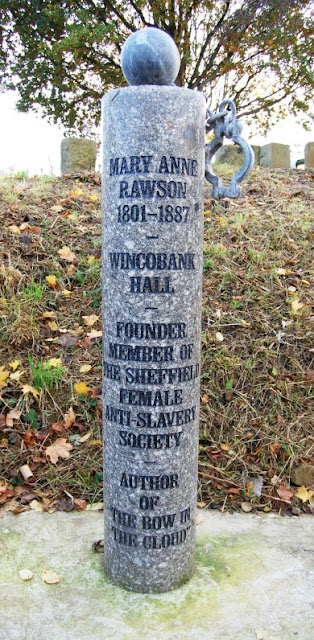Mary Anne Rawson (nee Read) was born in 1801 to wealthy parents who encouraged her involvement with good causes. She became actively involved in a number of philanthropic campaigns, including better conditions for chimney sweep boys, and better education for the poor. Her abiding interest from the mid-1820s onwards was championing the campaign for anti-slavery in both Sheffield and at a national level.
In 1825 Rawson became a founding member of the Sheffield Ladies Anti-Slavery Society, which campaigned for the rights of the slaves in the British Empire. The Sheffield society was one of the first Anti-Slavery Society to campaign for an immediate end to slavery, rather than the gradual and managed end advocated by more conservative abolitionists.
Through lectures, public meetings and pamphlet campaigns, the society raised awareness and successfully brought economic pressure to bear on plantation owners by implementing boycotts of goods produced by slave labour such as coffee, cotton and sugar. Featured is a pamphlet produced by the society, campaigning for a boycott of sugar produced by slaves in the West Indies, and advocating that people switched to buying East Indian goods instead, which were produced by paid workers.
Following the abolition of slavery in the British Empire in 1833, the society formally ended, but it was later re-established in 1857 to continue campaigning against slavery in other parts of the world. Anti-slavery organization’s run by women, such as Mary Ann Rawson and Lucy Townsend of Birmingham, were sometimes dismissed as of marginal interest, but recent research has revealed that these groups had a significant national impact.
Rawson corresponded with key figures in the abolitionist movement such as George Thompson in Britain, as well as Frederick Douglass and William Lloyd Garrison in the United States. Prominent campaign visitors to her home included Lord Shaftesbury and William Wilberforce. She was one of the few women to attend the world's first International Anti-Slavery Conference at Exeter Hall in London in 1840, which attracted delegates from America, France, Haiti, Australia, Ireland, Jamaica and Barbados. She can even be seen in the painting of ‘The Anti-Slavery Society Convention, 1840, by Benjamin Robert Haydon’ (Mary Anne can be seen in a bonnet in the front far right of the painting).
In 1841, Rawson and her sister, Emily Read, arranged for a day school to be created in the chapel on the grounds of their home at Wincobank Hall. The school was open to local children and became very successful. In 1860 the sisters created a trust to provide for its future financial endowment and management. The school continued until 1905.
Mary Anne continued to campaigning for the rights of fugitive slaves as well as other local charitable causes up until she retired from public life in 1875. She died in August 1887 at the age of 86.
To discover more, take a look at our Slavery and Abolition Research Guide.






No comments:
Post a Comment
Please leave your comments (subject to moderation).